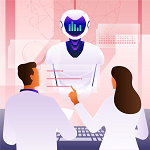


Discover the key challenges in healthcare application development, from regulatory compliance and data security to system integration and UX design.
The healthcare industry has experienced a massive digital transformation in recent years. The rise of mobile applications has enhanced accessibility, improved patient engagement, and streamlined healthcare services. However, developing a healthcare application comes with unique challenges that differentiate it from other types of applications. These challenges stem from regulatory compliance, data security concerns, integration complexities, and user experience considerations.
One of the biggest hurdles in healthcare app development is ensuring compliance with stringent regulations and legal requirements. Healthcare applications must adhere to various national and international standards to ensure patient data security and privacy. Some key regulatory frameworks include:
Failure to comply with these regulations can result in heavy penalties, lawsuits, and loss of trust. Implementing these compliance measures requires expert knowledge and constant updates to keep up with changing laws.
To mitigate this challenge:
Healthcare applications deal with sensitive patient data, making them prime targets for cyberattacks. A data breach can lead to significant legal consequences and reputational damage.
To ensure security:
Most healthcare facilities already use electronic health records (EHR) and hospital management systems (HMS). A new healthcare application must integrate seamlessly with these existing systems.
A healthcare application caters to a diverse audience, including patients, doctors, and administrative staff. The UI/UX must be intuitive and accessible to people with varying technical expertise and physical abilities.
A healthcare application should be capable of handling a growing number of users without compromising performance.
Healthcare App Development is a complex process that requires careful planning, adherence to regulatory standards, robust security measures, and seamless integration with existing systems. By understanding and addressing these challenges, developers can create innovative and efficient healthcare applications that improve patient outcomes and streamline medical processes.
As the healthcare industry continues to embrace digital transformation, overcoming these obstacles will be key to delivering impactful and successful healthcare applications.
